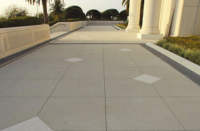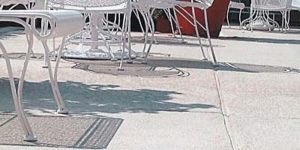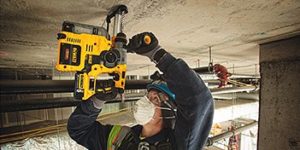In March of 2012 my company received a call from an outfit that was working on a project at San Joaquin Delta College in Stockton, California. They wanted to discuss the issues that they were having with the application of an acid stain on almost 50,000 square feet of floor.
The stain would go on three floors of a a new science and math complex to replace the Cunningham Building. One challenge was that on the bottom floor they had one kind of concrete, while on the second and third floor they had a specialty lightweight concrete.
Unfortunately the mix design specs were not really clear. They had also applied a water-based curing compound very inconsistently, in some areas very heavily. So this was a challenging project.
The contractor who was awarded the job to do the staining had walked away from the job during the mock-up process, from what I understand. He maybe was not able to deal with the pressure that comes with a job like this, especially when you have hundreds of people from different trades there and everybody’s working on top of you. This project was not disciplined at all.
Insisting on a new contract
On our contract, we had to make many changes to the specs and terms because they were not, to my belief, common industry standards. I had to immediately get my attorney involved. It cost me about $1,500 for his involvement but it was worth it. We presented some amendments to their package and their contract.
The specs said that we were supposed to install chemical stains followed by one coat of sealer and that’s it. And we’re talking about a school, with thousands of pedestrians and heavy use. So to my view the floor was not going to be protected.
There were no doors. Heaters were scattered all over. The temperature was in the low 40s. There were wires hanging. The lighting was very poor. And they never gave us whole floors completed. They gave us rooms at a time, and we had to be hopping through construction materials, over all the trays and electrical cords. This was one of the more miserable jobs I have ever done.
Thanks to my years of experience and planning, I was able to overcome and deal with the nightmare of delivering a product little by little so they could continue working.
I told them the most important part of my work was going to be prepping. We needed to strip out the curing compound and it was going to cost. All of that we had to explain to them.
And we had to deal with blemishes and damage to the concrete. Many of their electrical supplies were on the ground, and there were a lot because this is a large building.
I addressed all of those things in my contract before I started working. And this is why I think I succeeded on this job. I pay attention, and I saw all the problems before I started working. And I made sure that those problems were not my problems. We put it in writing.
Before I started working I presented them with a new contract and they agreed with the amendments. I understand now they had no choice. They had contacted other contractors and no one was willing to take the job, period. And because of the economy, there were not that many contractors left who had the expertise.
The original contract called for the contractor to repair all blemishes, but I said no, not on my contract. I didn’t want to get caught with that.
Fighting over color
We started doing mock-ups. But we could not get the stain reaction that the architect wanted. We made mock-ups as large as 3,000 square feet and still we could not get what they wanted.
At first, we had the reps from the stain company doing this, doing that. Finally I told them I needed to make my own mock-ups.
I brought in a Scofield vendor. I took a Padre Brown from L. M. Scofield Co. and I diluted samples 5-to-1, 3-to-1 and 2-to-1, then did three applications of the chemical stain. The architects saw A, B, C and D, and they picked A. I said, “OK, A is a Scofield Padre Brown diluted 3-to-1. And D, the one you like less, that’s the spec color applied three times. You have a choice. You decide what you want to do. If you want me to stay you need to change the specs and let me do the one you said you wanted.” They approved it and we went to work.
I also told them that I needed to make amendment changes to apply a minimum of two sealer coats and then, before the building opens, three or four more coats. And I needed to see all of that in writing. I wasn’t going to take my company to bankruptcy.
Cal/OSHA trouble
When we started working — two rooms at a time — I knew that if I managed myself I was going to be breaking even and if I didn’t I was going to lose my butt.
They had to put heaters in to control the temperature, and every day I would take temperature tests all day long. I would take hundreds of pictures of every single thing I was doing, because I knew I had to protect my company.
We were working for three days when suddenly Cal/OSHA shows up. Some of the other trades had complained that they were getting sick, headaches, that there were fumes. It had nothing to do with us, but they blamed it on us. Reportedly, they were getting fumes from the butane tanks that were being using to heat the rooms.
So Cal/OSHA demanded our company records. We had everything available and we gave it to them. Then they interviewed all of my employees. They did not allow me to be in the interviews. They wouldn’t let us continue working.
And within a couple of days, they said we could continue working, that everything was in order. Can you imagine if I wasn’t prepared? I could have gotten a $10,000 fine from Cal/OSHA.
Getting paid
Getting paid was difficult. We had to stay on top of it — we had to stop working at one point until we got progress payments. At what we thought was the end of the project we got a call to do a walk-through, and they wanted to do all kind of repairs. Repairs of things that we had nothing to do with. Big scratches, big blemishes. The general contractor had decided to repair holes themselves because they didn’t want to pay us. You can imagine what kind of repairs they did.
Color consistency
It was hard keeping the color consistent from room to room. Very hard. As I mentioned, we had started working in freezing temperatures and then moved into the summer months. The stain takes better when it is warmer. I asked for a record of mixes used and they wouldn’t give it to me. The building was poured in two sections and we saw a big difference in the stain right away.
We had to camouflage the stain a little bit. We had to play. We made dilution formulas a little bit different. We played with 4 to 1 and 3 to 1 as we needed to. That gave us what we were seeking.
At the cold joint, when you wet it you could see that one side took more water than the other. So on the side that took more water, we used a lighter dilution. And on the one that took it less we used a different dilution. And let me tell you, you cannot see the difference.
We did some mock-ups first. On the second floor we had to apply stain twice in certain sections after we had already cleaned it. But on the third floor we already knew what we had to do.
Cracks
Also, there were cracks on the second and third floor. I repaired some areas and showed them some ideas. The architects didn’t like the colors. I said, “OK, here’s the color chart. You can use whatever you want.” So the architect chose a brown that they liked.
They had to make another amendment saying they had to pay me for this. I had one guy spend three days doing crack repair.

The sealer
I would say it was close to a year between when we finished the stain and when we put on the first layers of sealer where it was needed. The floor was covered by a very good cardboard, a special roll-up paper, in the meantime, but it was still about a year later.
We ended up using sealer made by Surtec, out of California. We used a good bonding sealer and a high-gloss finish sealer. We used a company that has a history of providing those products locally to make it simple.
At almost the end of the project they gave me permission to go back to put on the extra coats of sealer that we recommended. The client agreed to that, so they sent us a purchase order. When you go to strip the floor you strip the finished sealer but you don’t strip the base sealer. It’s very important to understand that, because otherwise, you’d start eventually damaging some of the integrity of the stain.
The finished floor was beautiful. It looks very nice considering what we were dealing with.
Access to water and drainage
We were restricted on water supply. The water was a long way away. We had to use about 200 feet of hose to get to the second floor and 300 feet to get to the third floor.
We were also restricted on drainage because they said most of the drains were not connected so we couldn’t use them. There was a drain on each floor assigned to us on the far end. We had to walk, so you can imagine all the time it took for one employee to go and drain the water and come back.
Those kinds of things were discussed in our original meeting, but when we started working there were all kinds of excuses. Still, we had to perform and do what we had to do. The challenge was that when you have scrubbing machines, and you have vacuum equipment full of water, and you have to be hopping extension cords, obstacles and equipment, there’s a lot of downtime. You lose a lot of time and money.
We had to carry all of our equipment on the stairs. Every piece of equipment had to be lifted by hand because there were no elevators. The forklifts on-site can only be driven by a union person, and at the beginning they told us they were going to facilitate all of that for us, but when we were actually trying to perform they were too busy to help.
A conflict over drain cover damage
They blamed us for contaminating all of the drain covers. The plumber wanted to change all of the drains and charge thousands of dollars. I said that it is an industry standard for us to cover the drains, which we did. We had pictures. It’s also an industry standard that these drains come from the manufacturing company with plastic tape that is removed at the end of the job. I took a knife and I showed them on one of the ones they had blue-taped to say I was going to have to pay for it. Right in front of their faces I removed the tape and there was a beautiful gorgeous drain cover. And I said, ‘You know, your plumber is being dishonest to you. Your plumber wants to stick it to me and put in all kind of drains when there’s nothing wrong.’
I also told them that a lot of the contamination they saw had nothing to do with me because I didn’t do the repairs. The repairs were done by their own people. So you can’t blame me for that. That took care of that problem.
There were scratches that went 30, 40 feet, 60 feet long. I got pictures when we finished and had a walk-through. You get those kind of scratches by dragging furniture, by dragging things that you don’t have on a proper pallet, by using a dolly when one of the wheels is stuck. It’s called negligence.
How this could have been avoided
Every contractor needs to understand mixes. You need to understand concrete before you do staining. You need to understand that regular concrete is going to take stain very differently from a lightweight concrete. A lightweight concrete is going to take the stain lighter, it’s going to confuse you, and its never going to give you the same look as the other floor.
I got the floors to look pretty consistent. I changed my formula. But I also made the clients sign a waiver. I also communicated by email very heavily with our client. Every single day I wrote out my performance on the job site and added my comments, and I copied it to everybody in the contracting company.
Unfortunately this job was too complicated: a new state building, all kind of regulations. The general contractor’s planning can be blamed for not dealing with a proper schedule and having too many redos. But I’m not putting all the blame on the general contractor. They spent a lot of money on a special heavy paper to protect the floors, so they did some great things. And their project manager is an unbelievable guy, to manage and deal with so many issues. We stayed on the job site because of him. The man has a lot of ethics and he knows how to manage a project. He worked with us very well.
The school and general contractor are in litigation right now. We recently submitted some paperwork to the president of the college and to that administration to get paid our retainer. It was only about $20,000. But 20 grand is 20 grand. And I want my 20 grand.
The total job ended up being billed at about $160,000, and let me tell you, that job should have been at least a quarter of a million dollars the way it went.
Luckily, because we followed all the step by steps that you’re supposed to as businesspeople, because we followed the law and everything else, we broke even, but it’s a sad situation. A beautiful project, beautiful building, beautiful architecture. Why did things go so wrong? But the end product is not what it should be.
The biggest nightmare that I see is that contractors don’t learn their lesson and they continue underbidding themselves. Our industry is lacking business understanding. They want to get a job. But If you want to just get a job, do something else. If you want to stay in this business, learn how to bid it correctly.
Do your homework. Don’t run into trouble. Meet with the manufacturing companies. Learn about cases similar to what you are doing. Get history and prepare yourself. Don’t risk yourself and your business.
Also, exercise your contractor rights and send preliminary notices if you need to. File mechanic’s liens and stop notices if you do not get paid on time.
After 25, 26 years in the business I’ve done it all. But this job taught me many lessons. I could write a book about this job. I’d love to help everybody understand that when you are working with the state, when you are doing government work, when you are doing prevailing wage, you need to be very well-informed and educated about the law, especially when you have to sign and give a year warranty in writing knowing the conditions you’re going to be facing. So, take pictures, pictures, pictures everyday. Take temperature readings and record at what time you took them.
I’m very responsible and I had to honor my contract and I did. And I think a lot of people see that. A lot of the subcontractors saw us performing and they complimented our discipline, they complimented our performance. They said, “We don’t know how you guys can do that.”
Project at a Glance
Client: San Joaquin Delta College, Stockton, California
Replacement flooring contractor: Concrete by Hallack, Turlock, California | www.concretebyhallack.com
General contractor: Taisei Construction Corp., Cypress, California | www.taisei.co.jp/english
Scope of project: Julio Hallack took over this job after the initial contractor walked away. The job involved application of a stain on almost 50,000 square feet of floor over a three-story building.
Project duration: Hallack worked on the project from March 2012 to April 2013. The building officially opened in January 2014.
Tools and materials used: Lithochrome Chemstain Classic acid stain from L. M. Scofield Co. in Padre Brown; bonding sealer and high-gloss finish sealer from Surtec; Padco T-bar applicators.



















